| Article ID | Journal | Published Year | Pages | File Type |
|---|---|---|---|---|
| 4925516 | Nuclear Engineering and Design | 2017 | 10 Pages |
â¢Numerical simulations of flow induced vibration of nuclear fuel rods in axial turbulent flows.â¢Fluid-structure interaction simulations of strongly coupled problems.â¢Assessment of partitioned coupling algorithms and discretization schemes suitable for strongly coupled FSI problems.â¢Checking the effect of the use of different URANS models to simulate Turbulence Induced Vibrations.â¢Validating the results obtained from the URANS models to experimental test cases.
Flow induced vibration (FIV) plays an important role in nuclear industry. In nuclear reactors, the FIV are caused by a strong interaction between the fuel rods and the turbulent coolant flow around these rods. Numerical prediction of these strongly coupled fluid structure interaction (FSI) has been a challenge and is the main focus of this work. In this article, three aspects of FSI problems are numerically studied. In this first part, two different coupling schemes namely IQN-ILS and Guess-Seidel are thoroughly assessed for a laminar flow single rod experiment performed by Vattenfall (Lillberg et al. 2015). As a next step, a turbulent flow single rod experiment is selected to assess the capabilities of two different RANS models, i.e. a linear k-ÏSST and a non-linear Reynolds Stress Model. Lastly, an application based experiment of Chen and Wambsganns (1972) is selected to validate the combined effect of the selected RANS model along with the coupling method.
